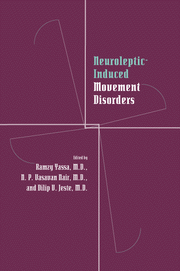Book contents
- Frontmatter
- Contents
- Contributors
- Preface
- Part I Historical perspective
- Part II Clinical aspects of tardive dyskinesia
- Part III Mechanisms underlying tardive dyskinesia
- 11 Neurochemistry of the basal ganglia
- 12 A reanalysis of the dopamine theory of tardive dyskinesia: the hypothesis of dopamine D1/D2 imbalance
- 13 Tardive dyskinesia and phenylalanine metabolism: risk-factor studies
- 14 Neuroendocrinological studies of tardive dyskinesia
- 15 Cognitive deficits and tardive dyskinesia
- 16 Studies of tardive dyskinesia using computed tomography and magnetic-resonance imaging
- 17 Rodent and other animal models of tardive dyskinesia during long-term neuroleptic-drug administration: controversies and implications for the clinical syndrome
- Part IV Measurement of tardive dyskinesia
- Part V Tardive dyskinesia in different populations
- Part VI Other neuroleptic-induced movement disorders
- Part VII Treatment of tardive dyskinesia
- Index
16 - Studies of tardive dyskinesia using computed tomography and magnetic-resonance imaging
from Part III - Mechanisms underlying tardive dyskinesia
Published online by Cambridge University Press: 09 October 2009
- Frontmatter
- Contents
- Contributors
- Preface
- Part I Historical perspective
- Part II Clinical aspects of tardive dyskinesia
- Part III Mechanisms underlying tardive dyskinesia
- 11 Neurochemistry of the basal ganglia
- 12 A reanalysis of the dopamine theory of tardive dyskinesia: the hypothesis of dopamine D1/D2 imbalance
- 13 Tardive dyskinesia and phenylalanine metabolism: risk-factor studies
- 14 Neuroendocrinological studies of tardive dyskinesia
- 15 Cognitive deficits and tardive dyskinesia
- 16 Studies of tardive dyskinesia using computed tomography and magnetic-resonance imaging
- 17 Rodent and other animal models of tardive dyskinesia during long-term neuroleptic-drug administration: controversies and implications for the clinical syndrome
- Part IV Measurement of tardive dyskinesia
- Part V Tardive dyskinesia in different populations
- Part VI Other neuroleptic-induced movement disorders
- Part VII Treatment of tardive dyskinesia
- Index
Summary
Tardive dyskinesia is an involuntary hyperkinetic movement disorder associated with long-term exposure to antipsychotic medication (Casey, 1987). Its prevalence, estimated at 15–20% overall, is considerably higher among elderly subjects (Kane & Smith, 1982; Kane et al., 1984; Woerner et al., 1991; Yassa et al., 1992), and because of its variable outcomes, the absence of any effective treatment, and the potential for legal implications, tardive dyskinesia is of considerable concern to clinicians who prescribe maintenance antipsychotic drugs (Jeste & Wyatt, 1982a; Jeste et al., 1988; Shriqui, 1988; Bergen et al., 1989; Shriqui, Bradwejn, & Jones, 1990; Casey, 1991; Kane et al., 1992; Yassa & Nair, 1992).
Despite considerable research efforts, the pathophysiology and neuroanatomic picture of tardive dyskinesia remain largely unknown (Jeste & Wyatt, 1982b; Kane et al., 1984; Casey, 1991). Although dopaminergic supersensitivity may be an essential component in the emergence of tardive dyskinesia, recent hypotheses involving other neurotransmitters (e.g., γ-aminobutyric acid, norepinephrine, serotonin, acetylcholine), iron metabolism, diminished melatonin secretion, and free-radical neurotoxicity have been advanced (Jeste et al., 1986; Cadet, Lohr, & Jeste, 1987; Sandyk & Fischer, 1988; Lohr et al., 1990; Sandyk, 1990a; Shriqui & Jones, 1990; Lohr, 1991).
Neuropathological studies of tardive dyskinesia patients have reported increased nigral degeneration and gliosis (Christensen, Moller, & Faurbye, 1970; Arai et al., 1987). Pineal-gland calcification has also been reported and suggested as a potential neuroradiologic marker of persistent tardive dyskinesia in schizophrenic and bipolar patients (Sandyk, Awerbuch, & Kay, 1990; Sandyk, 1990b).
- Type
- Chapter
- Information
- Neuroleptic-induced Movement DisordersA Comprehensive Survey, pp. 207 - 224Publisher: Cambridge University PressPrint publication year: 1996



